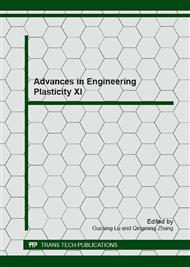p.231
p.235
p.239
p.243
p.247
p.250
p.254
p.263
p.267
Closure Behavior of Longitudinal Cavities in a Slab by Side Pressing
Abstract:
Longitudinal cavities or pipes are usually developed in a metallic slab or billet produced by continuous casting. In the present study, closure behavior of such cavities by side pressing was investigated by finite-element method. Since the contact surface between the dies and the slab was much longer in the longitudinal direction than in the thickness direction, the slab was compressed under the condition of plane-strain deformation. As a result, the effective strain was found to be an indicator for the void closure. The critical value of the effective strain was dependent upon the aspect ratio of the cross section of the cavity, but not upon its size.
Info:
Periodical:
Pages:
247-249
Citation:
Online since:
January 2013
Authors:
Keywords:
Price:
Сopyright:
© 2013 Trans Tech Publications Ltd. All Rights Reserved
Share:
Citation:


